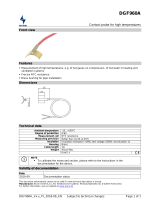
3.5 HEATING AND HOT WATER CONNECTIONS
• Cold & Hot Water Connections.
The cold water inlet and hot water outlet connections are G 1/2" male thread
connections. Use 2 x 1/2" female to 15mm pipe adapters with an isolation valve fitted
to the cold supply connection. Make sure that the pressure of the mains water does
not exceed 6 Bar. If the Mains Water pressure is more than 6 Bar a pressure
reduction valve must be fitted. The minimum required pressure is 0,8 Bar. For hard
water areas a water softener must be used. Salt softeners must not be used to fill the
heating system.
Note:
Set the correct flow rate for the boiler output as shown in the table on page 27. If the
flow rate is set to high the Hot Water outlet temperature will not be acheived.
• Flow & Return Connections.
Flow & Return connections are G 3/4" male thread. Use 2 x 3/4" female to 22mm pipe
adapters along with 2 x full bore isolation valves to provide good system circulation. A
minimum of 1m of copper pipe must be used on all connections from the boiler. The
boilers are fitted with Wilo smart pumps that can be adjusted if required. Refer to the
pump section below. An external magnetic filter must be used on all installations.
• PRV.
The boilers are fitted with a 3bar pressure relief valve that will automatically activate if
the system pressure is ever increased above 3 bar. The PRV should never be used
as a drain point as this could cause the device to leak.
• Bypass.
When thermostatic valves are used and close due to the room temperatures being
achieved the boilers internal bypass will operate. The automatic by-pass system will
provide the minimum circulation requirement for the heat exchanger.
• Insulation.
We recommend that all pipe-work is insulated where practical. Especially the primary
pipe-work with in a boiler cupboard. This will reduce heat loss and protect the
cupboard from high temperatures.
• System Filling.
A WRAS approved filling loop must be used and installed in such a way that it never
becomes a permanent connection to the mains water and the heating system itself.
The heating system should be filled to 1.5 bar when cold and topped up accordingly
during commissioning and general system maintenance.
8






















